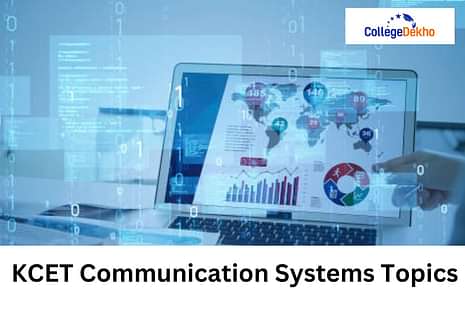KCET Communication Systems Topics 2025 Propagation of Electromagnetic Waves, Free Space and Optical Fibers, Range, Amplification, Attenuation, Transmitter, Bandwidth of Transmission Medium for Coaxial Cable, etc. Check the complete details of this topic here.

KCET Communication Systems Topics 2025 include
Propagation of Electromagnetic Waves, Free Space and Optical Fibers, Range, Amplification, Attenuation, Noise, Receiver, Transmitter, Bandwidth of Transmission Medium for Coaxial Cable, Bandwidth, Attenuation, Noise, Signal, Block Diagram of Generalized Communication System etc. Communication Systems chapter is one the important chapter of
KCET 2025 Physics Syllabus.
Candidates planning to appear for the
KCET 2025 exam
can expect around 3 questions from this chapter. Some of the important topics in this chapter are Bandwidth, Range, Free Space & Optical Fibers, Block Diagram of Generalized Communication Systems etc.
According to the official schedule, the KCET 2025 exam will be conducted on April 16 and 17, 2025 and the KCET application form 2025 has been released. Students can fill out and submit the application form by February 21, 2025. Candidates can go through
KCET 2025 Syllabus
and prepare well for the examination.
Read Also:
KCET 2025 Communication Systems Topics
KCET Communication Systems Topics 2025 have been provided in the following table.
- Propagation of Electromagnetic Waves
- Free Space and Optical Fibers
- Bandwidth of Transmission Medium for Coaxial Cable
- Bandwidth
- Range
- Amplification
- Attenuation
- Receiver
- Transmitter
- Noise
- Signal
- Transducer
- Block Diagram of Generalized Communication System
Also read: How to Prepare for KCET 2025
Important Topics of KCET Communication Systems 2025
Here are some of the topics that are included in the Communication Systems chapter of the KCET 2025 Syllabus . aspirants can have a look at them.
- Bandwidth, Range
- Free Space & Optical Fibres
- Bandwidth of Transmission Medium for Coaxial Cable
- Block Diagram of Generalized Communication System
Important Terminology of KCET Communication Systems 2025
Candidates preparing for the Communication Systems chapter can utilize the key terminology provided here to have a better understanding of the concepts.
Communication Systems Important Terminology | Brief Explanation |
|---|---|
Signal | Direct transmission is not possible for any created audio, video, or audio-visual content. It must be transformed into an electronic format first. This electronic format is known as a signal. |
Wavelength | The distance between two particles that are in sync with one another and have the same displacement is known as the wavelength. |
Amplitude | Suppose that a sinusoidal wave travels through a sequence of particles that oscillate around a mean position, transferring energy through space. The sinusoidal wave's "amplitude" is the biggest deviation that a particle can have from its mean position. |
Bandwidth | The difference between a signal's highest and lowest frequencies is known as its bandwidth. |
Amplification | Amplification is the process of raising a signal's amplitude. For instance, your voice is amplified and audible farther away anytime when you talk into a microphone. Only the signal's amplitude rises during this operation. |
Attenuation | A signal's quality and strength are lost during long-distance electronic transmission because of natural energy wastage. This is the signal's "attenuation." This is prevented or the signal's damage is reduced through constant efforts and a variety of techniques. |
Receiver | A receiver is a machine that takes data from a signal and converts it into a format that may be used. It is a part of a communication system that also consists of a channel and a sender. |
Transmitter | An electrical telecommunications equipment used for data transmission is called a transmitter. |
Noise | Any undesired signal that obstructs a message's transmission or processing and makes it harder for the recipient to interpret is considered noise in a communication system. |
Transducer | Any device that transforms a physical variable—such as force, movement, etc.—into an electronic signal and provides an appropriate output for it is called a transducer. |
Also Read: KCET Sample Papers
Best Books for KCET 2025 Communication Systems
KCET aspirants should be aware of the best books that they will need for the preparation of the chapter Communication Systems for the exam. They can refer to the best books here.
- Class 11 and 12 NCERT textbooks
- Physics for Karnataka CET and COMEDK
- Fundamentals of Physics by S Chand
- Physics for first year PUC by AS Govind
Related Articles:
Are you feeling lost and unsure about what career path to take after completing 12th standard?
Say goodbye to confusion and hello to a bright future!

FAQs
It is not mandatory to attempt the Biology paper in the KCET exam if you want to opt for Engineering. Biology marks are only considered for the Medical, Dental and Paramedical fields. However, if you want to pursue Biotechnology in Engineering, attempting Biology in the KCET exam is compulsory.
50% mark is the passing percentage for the general category candidates and 40% for the SC/ST/OBC category for the KCET exam.
As per the previous year exam analysis, the KCET 2025 exam might be of a moderate to difficult level. KCET questions will be based on the first and second-year PUC syllabus as determined by the Department of Pre-University Education of Karnataka State.
Candidates cannot skip Mathematics in the KCET exam. Mathematics is a mandatory subject in the KCET exam, and skipping it would disqualify candidates from the KCET examination.
Candidates looking to score good marks in the Karnataka CET exam are advised to solve the KCET previous year question papers and mock tests. Solving PYQs of KCET will enable candidates to get an idea about the KCET question paper pattern and the marking scheme.
NCERT best books are a good choice for candidates to start if they want to prepare for the KCET 2025 exam. Upon finishing the NCERT books, candidates can move ahead to the crucial KCET best books. Additionally, the KCET best books are another resource that candidates can use to study for the KCET exam.
In KCET Physics, chapters such as Gravitation, Motion in a Straight Line, Oscillations, and Thermodynamics each contribute approximately 7% to 8% of the exam paper.
Chapters with maximum weightage in KCET Physics are Gravitation, Motion in a Straight Line, Oscillations and Thermodynamics since they carry 7% to 8% weightage. Important chapters for KCET Maths comprise Integration, Vectors, Permutation and Combination, and 3-D Geometry which weigh around 6% to 7% in the KCET exam.
The KCET exam holds a total number of 180 questions in the exam out of which 60 questions will be based on the physics syllabus.
Applicants might find some concepts in the chapter tough but they can prepare it with the right strategy.
There will be around 4-5 questions from the communication systems chapter.
The topics in the communication systems chapter are propagation of electromagnetic waves, free space & optical fibres, bandwidth of transmission, transducer, signal, transmitter, amplitude, wavelength, etc.
Was this article helpful?



















Similar Articles
JEE Advanced IIT Madras CSE Cutoff 2025
JEE Advanced IIT BHU Civil Engineering Cutoff 2025
JEE Advanced IIT Bombay CSE Cutoff 2025
List of Documents Required for AP ECET 2025 Counselling
List of Documents Required for AP POLYCET Counselling 2025
Do's and Dont's of AP POLYCET Web Options 2025